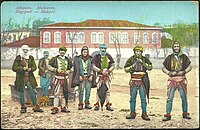Tuzi
Tuzi
Тузи Tuz | |
|---|---|
Town and municipality | |
 View of the Accursed Mountains | |
 Flag  Coat of arms | |
 Tuzi Location within Montenegro | |
| Coordinates: 42°21′56″N 19°19′53″E / 42.36556°N 19.33139°E | |
| Country | |
| Municipality | |
| Government | |
| • Mayor | Nik Gjeloshaj (AA) |
| Population (2011) | |
| • Urban | 4,748 |
| • Rural | 6,674 |
| • Municipality | 11,422 |
| Time zone | UTC+1 (CET) |
| • Summer (DST) | UTC+2 (CEST) |
| Postal code | 81206 |
| Area code(s) | +382 20 |
| Vehicle registration | TZ |
| Climate | Cfa |
Tuzi (Montenegrin: Тузи, pronounced [tǔːzi]; Albanian: Tuz or Tuzi) is a small town and seat of Tuzi Municipality, Montenegro. It is located along a main road between the city of Podgorica and the Albanian border crossing, just a few kilometers north of Lake Skadar. The Church of St. Anthony and Qazimbeg's Mosque are located in the centre of the town. Tuzi is the newest municipality in Montenegro, becoming an independent municipality since 1st September 2018.
Geography[]
Tuzi is situated to the northwest of Lake Shkodra, 10 km from Podgorica, 150 km from Dubrovnik (Croatia) and 130 km to Tirana (Albania). It is located in surrounded by forests and mountains that are further connected with Accursed Mountains.
History[]
| Part of a series on |
| Albanian tribes |
|---|
 |
The town of Tuzi is situated in Southeastern Montenegro, between Podgorica and the Skadar lake. The Albanian community of Tuzi descend from the surrounding tribes of Hoti, Gruda, Trieshi and Koja, part of the Malësor tribes.
Tuzi is mentioned in 1330 in the Dečani chrysobulls as part of the Albanian (arbanas) katun (semi-nomadic pastoral community) of Llesh Tuzi (Ljesa Tuzi in the original), in an area stretching southwards from modern Tuzi Municipality along the Lake Skadar to a village near modern Koplik. This katund included many communities that later formed their own separate communities: Reçi and his sons, Matagushi, Bushati and his sons, Pjetër Suma and Pjetër Kuçi, first known ancestor of Kuči.[1] Llesh Tuzi is the first named progenitor of the Tuzi tribe (fis), which gave its name to the settlement of Tuzi. The Suma and Tuzi fis formed the vast majority of the later Gruda community.
Following the Great Schism of 1054, the tribes of Tuzi embraced Roman Catholicism over that of Eastern Orthodoxy. Following the expansion of Ottoman rule in the Balkans in the 14th century, many gradually converted to Islam. Some of them adopted new surnames common among Ottoman Muslims while others kept their original surnames. Albanian surnames present among Muslim and Christian families alike include Gjokaj, Nikaj, Dreshaj, etc.
The Albanian flag was raised for the first time in possibly over 400 years in the Battle of Deçiq (6 April) in the Albanian revolt of 1911 in the Deçiq mountain near Tuzi. It was raised by Ded Gjo Luli on the peak of Bratila after victory was secured. The phrase "Tash o vllazën do t’ju takojë të shihni atë që për 450 vjet se ka pa kush" (Now brothers you have earned the right to see that which has been unseen for 450 years) has been attributed to Ded Gjo Luli by later memoirs of those who were present when he raised the flag.[2] It was one of three banners brought to Malësia by Palokë Traboini, student in Austria. The other two banners were used by Ujka of Gruda and Prelë Luca of Triepshi.[3]
21st century[]
From the 24th of March 2020 until further notice, the entire Tuzi Municipality was put onto a complete lockdown in response to the sudden increase of cases of the COVID-19 pandemic in Tuzi, with only essential services allowed to operate. Tuzi is the first municipality in Montenegro that was put in a complete lockdown in the pandemic.[4]
Sports[]
The local football club is Dečić, who play in the Montenegrin First League. Their home venue is the Stadion Tuško Polje and their reserve team plays in the Montenegrin Third League.
Demographics[]
According to 2011 census, the town of Tuzi has a population of 4,748,[5] while Tuzi Municipality has 11,422 residents.[6]
| Ethnicity | Number | Percentage |
|---|---|---|
| Albanians | 2,383 | 50.2% |
| Bosniaks | 932 | 19.6% |
| Montenegrins | 554 | 11.7% |
| Roma | 111 | 2.3% |
| Turks | 15 | 0.3% |
| Serbs | 13 | 0.3% |
| Egyptians | 6 | 0.1% |
| other/undeclared | 734 | 15.5% |
| Total | 4,748 | 100% |
References[]
- ^ Pulaha, Selami (1975). "Kontribut për studimin e ngulitjes së katuneve dhe krijimin e fiseve në Shqipe ̈rine ̈ e veriut shekujt XV-XVI' [Contribution to the Study of Village Settlements and the Formation of the Tribes of Northern Albania in the 15th century]". Studime Historike. 12: 94-5. Retrieved 30 January 2020.
- ^ Verli, Marenglen (2014). "The role of Hoti in the uprising of the Great Highlands". Studime Historike (1–2).
- ^ Martin, Traboini (1962). "Mbi kryengritjen e Malsisë së Madhe në vitet 1911-1912". In Pepo, Petraq (ed.). Kujtime nga lëvizja për çlirimin kombetar (1878-1912). University of Tirana. p. 446.
- ^ "Montenegro Places First Town under Total Quarantine". Balkan Insight. 25 March 2020.
- ^ http://www.monstat.org/userfiles/file/popis2011/podaci%20naselja/Tabela%20N1.xls Population and Housing Census in Montenegro - ethnicity

- ^ Zvanični rezultati popisa na web stranici Zavoda za statistiku Crne Gore
- Populated places in Tuzi Municipality
- Albanian communities in Montenegro
